Complementary Sampling Methods to Improve the Monitoring of Coastal Lagoons
Abstract
1. Introduction
2. Materials and Methods
2.1. Study Site and Sampling Stations
2.2. Sampling Gears
2.2.1. Twenty-Five-Meter and Fifty-Meter Beach Seines
2.2.2. Beam Trawl
2.2.3. Riley Push Net
2.2.4. Processing of Fish Collected
2.3. Data Analysis
2.3.1. Assemblage Composition and Structure
2.3.2. Diversity Indices
3. Results
3.1. Assemblage Structure
3.2. Diversity Indices
4. Discussion
5. Conclusions
Supplementary Materials
Author Contributions
Funding
Institutional Review Board Statement
Data Availability Statement
Acknowledgments
Conflicts of Interest
References
- Whitfield, A.K. The role of seagrass meadows, mangrove forests, salt marshes and reed beds as nursery areas and food sources for fishes in estuaries. Rev. Fish Biol. Fish. 2016, 27, 75–110. [Google Scholar] [CrossRef]
- Unsworth, R.K.; Nordlund, L.M.; Cullen-Unsworth, L.C. Seagrass meadows support global fisheries production. Conserv. Lett. 2018, 12, e12566. [Google Scholar] [CrossRef]
- Abookire, A.; Piatt, J.; Robards, M. Nearshore Fish Distributions in an Alaskan Estuary in Relation to Stratification, Temperature and Salinity. Estuar. Coast. Shelf Sci. 2000, 51, 45–59. [Google Scholar] [CrossRef]
- Erzini, K.; Bentes, L.; Coelho, R.; Correia, C.; Lino, P.G.; Monteiro, P.; Ribeiro, J.; Gonçalves, J.M.S. Recruitment of Sea Breams (Sparidae) and Other Commercially Important Species in the Algarve (Southern Portugal); REF. NO. 99/061, Final Report. Commission of the European Communities DG XIV/C/1; 2002; 265p. Available online: https://ec.europa.eu/info/departments/maritime-affairs-and-fisheries_en (accessed on 1 July 2022).
- Lazzari, M.A.; Tupper, B. Importance of Shallow Water Habitats for Demersal Fishes and Decapod Crustaceans in Penobscot Bay, Maine. Environ. Biol. Fishes 2002, 63, 57–66. [Google Scholar] [CrossRef]
- Seitz, R.D.; Wennhage, H.; Bergström, U.; Lipcius, R.N.; Ysebaert, T. Ecological value of coastal habitats for commercially and ecologically important species. ICES J. Mar. Sci. 2013, 71, 648–665. [Google Scholar] [CrossRef]
- Nordlund, L.M.; Unsworth, R.K.F.; Gullström, M.; Cullen-Unsworth, L.C. Global significance of seagrass fishery activity. Fish Fish. 2017, 19, 399–412. [Google Scholar] [CrossRef]
- Travers, M.J.; Potter, I.C. Factors influencing the characteristics of fish assemblages in a large subtropical marine embayment. J. Fish Biol. 2002, 61, 764–784. [Google Scholar] [CrossRef]
- Ribeiro, J.; Bentes, L.; Coelho, R.; Gonçalves, J.M.; Lino, P.G.; Monteiro, P.; Erzini, K. Seasonal, tidal and diurnal changes in fish assemblages in the Ria Formosa lagoon (Portugal). Estuar. Coast. Shelf Sci. 2006, 67, 461–474. [Google Scholar] [CrossRef]
- Halpern, B.S.; Selkoe, K.A.; Micheli, F.; Kappel, C.V. Evaluating and Ranking the Vulnerability of Global Marine Ecosystems to Anthropogenic Threats. Conserv. Biol. 2007, 21, 1301–1315. [Google Scholar] [CrossRef]
- Vasconcelos, R.P.; Reis-Santos, P.; Fonseca, V.; Maia, A.; Ruano, M.; França, S.; Vinagre, C.; Costa, M.J.; Cabral, H. Assessing anthropogenic pressures on estuarine fish nurseries along the Portuguese coast: A multi-metric index and conceptual approach. Sci. Total Environ. 2007, 374, 199–215. [Google Scholar] [CrossRef]
- European Parliament and Council. Directive 2000/60/EC of the European Parliament and of the Council of 23 October 2000 establishing a framework for Community action in the field of water policy. Off. J. Eur. Communities L 2000, 327, 72. [Google Scholar]
- Jackson, J.B.C.; Kirby, M.X.; Berger, W.H.; Bjorndal, K.A.; Botsford, L.W.; Bourque, B.J.; Bradbury, R.H.; Cooke, R.; Erlandson, J.; Estes, J.A.; et al. Historical Overfishing and the Recent Collapse of Coastal Ecosystems. Science 2001, 293, 629–637. [Google Scholar] [CrossRef]
- Grant, J. The relative magnitude of biological and physical sediment reworking in an intertidal community. J. Mar. Res. 1983, 41, 673–689. [Google Scholar] [CrossRef]
- Allgeier, J.E.; Yeager, L.; Layman, C.A. Consumers regulate nutrient limitation regimes and primary production in seagrass ecosystems. Ecology 2013, 94, 521–529. [Google Scholar] [CrossRef]
- Heip, C.H.R.; Herman, P.M.J.; Soetaert, K. Indices of diversity and evenness. Océanis 1998, 24, 61–87. [Google Scholar]
- Villéger, S.; Mason, N.W.H.; Mouillot, D. New multidimensional functional diversity indices for a multifaceted framework in functional ecology. Ecology 2008, 89, 2290–2301. [Google Scholar] [CrossRef]
- Cadotte, M.W.; Davies, T.J.; Regetz, J.; Kembel, S.; Cleland, E.; Oakley, T. Phylogenetic diversity metrics for ecological communities: Integrating species richness, abundance and evolutionary history. Ecol. Lett. 2010, 13, 96–105. [Google Scholar] [CrossRef]
- Petchey, O.L.; Gaston, K.J. Functional diversity: Back to basics and looking forward. Ecol. Lett. 2006, 9, 741–758. [Google Scholar] [CrossRef]
- Villéger, S.; Miranda, J.R.; Hernández, D.F.; Mouillot, D. Contrasting changes in taxonomic vs. functional diversity of tropical fish communities after habitat degradation. Ecol. Appl. 2010, 20, 1512–1522. [Google Scholar] [CrossRef]
- Flynn, D.F.B.; Mirotchnick, N.; Jain, M.; Palmer, M.I.; Naeem, S. Functional and phylogenetic diversity as predictors of biodiversity–ecosystem-function relationships. Ecology 2011, 92, 1573–1581. [Google Scholar] [CrossRef]
- Mouillot, D.; Graham, N.A.; Villéger, S.; Mason, N.W.; Bellwood, D.R. A functional approach reveals community responses to disturbances. Trends Ecol. Evol. 2013, 28, 167–177. [Google Scholar] [CrossRef] [PubMed]
- Bosch, N.E.; McLean, M.; Zarco-Perello, S.; Bennett, S.; Stuart-Smith, R.D.; Vergés, A.; Pessarrodona, A.; Tuya, F.; Langlois, T.; Spencer, C.; et al. Persistent thermally driven shift in the functional trait structure of herbivorous fishes: Evidence of top-down control on the rebound potential of temperate seaweed forests? Glob. Chang. Biol. 2022, 28, 2296–2311. [Google Scholar] [CrossRef] [PubMed]
- Cabral, H.; Fonseca, V.; Gamito, R.; Gonçalves, C.; Costa, J.; Erzini, K.; Gonçalves, J.; Martins, J.; Leite, L.; Andrade, J.; et al. Ecological quality assessment of transitional waters based on fish assemblages in Portuguese estuaries: The Estuarine Fish Assessment Index (EFAI). Ecol. Indic. 2012, 19, 144–153. [Google Scholar] [CrossRef]
- Pérez-Domínguez, R.; Alvarez, M.C.; Borja, A.; Cabral, H.; Courrat, A.; Elliott, M.; Fonseca, V.; Franco, A.; Gamito, R.; Garmendia, J.M.; et al. Deliverable D4.4–5: Precision and Behaviour of Fish-Based Ecological Quality Metrics in Relation to Natural and Anthropogenic Pressure Gradients in European Estuaries and Lagoons. Water Bodies in Europe: Integrative Systems to Assess Ecological Status and Recovery (WISER), Seventh Framework Programme Collaborative Project (Large-Scale Integrating Project), Grant Agreement 226273, 2012, 71p. Final Report. Available online: https://repositorio.ul.pt/bitstream/10451/37777/1/MARE_ULisboa_WISER_D4.4-5.pdf (accessed on 1 July 2022).
- Coates, S.; Waugh, A.; Anwar, A.; Robson, M. Efficacy of a multi-metric fish index as an analysis tool for the transitional fish component of the Water Framework Directive. Mar. Pollut. Bull. 2007, 55, 225–240. [Google Scholar] [CrossRef]
- Dembkowski, D.J.; Wuellner, M.R.; Willis, D.W. Sampling Glacial Lake Littoral Fish Assemblages with Four Gears. N. Am. J. Fish. Manag. 2012, 32, 1160–1166. [Google Scholar] [CrossRef]
- Baker, D.G.; Eddy, T.D.; McIver, R.; Schmidt, A.L.; Thériault, M.-H.; Boudreau, M.; Courtenay, S.C.; Lotze, H.K. Comparative analysis of different survey methods for monitoring fish assemblages in coastal habitats. PeerJ 2016, 4, e1832. [Google Scholar] [CrossRef]
- Butcher, A.; Mayer, D.; Smallwood, D.; Johnston, M. A comparison of the relative efficiency of ring, fyke, fence nets and beam trawling for estimating key estuarine fishery populations. Fish. Res. 2005, 73, 311–321. [Google Scholar] [CrossRef]
- Dahm, E. Chapter 6: Sampling with active gear. In Guidelines for Sampling Fish in Inland Waters; FAO, Fisheries and Aquaculture Department: Rome, Italy, 1980; Available online: http://www.fao.org/docrep/003/AA044E/AA044E06.htm (accessed on 16 January 2019).
- Elliot, M.; Hemingway, K. Fishes in Estuaries. Blackwell Science Ltd: Oxford, UK, 2002. [Google Scholar]
- Bosch, N.E.; Gonçalves, J.M.S.; Erzini, K.; Tuya, F. “How” and “what” matters: Sampling method affects biodiversity estimates of reef fishes. Ecol. Evol. 2017, 7, 4891–4906. [Google Scholar] [CrossRef]
- Rotherham, D.; Johnson, D.D.; Kesby, C.L.; Gray, C.A. Sampling estuarine fish and invertebrates with a beam trawl provides a different picture of populations and assemblages than multi-mesh gillnets. Fish. Res. 2012, 123–124, 49–55. [Google Scholar] [CrossRef]
- Águas, M.P.N. Simulação da circulação hidrodinâmica na Ria Formosa. In Os sistemas Lagunares do Algarve; University of Algarve: Faro, Portugal, 1986; pp. 78–90. [Google Scholar]
- Diário da República. Decreto-Lei n° 373/87; Ministério do Planeamento e da Administração do Território Série I; Imprensa Nacional-Casa da Moeda: Lisbon, Portugal, 1987; pp. 4257–4263. [Google Scholar]
- IUCN. Protected Area Categories. 2020. Available online: https://www.iucn.org/theme/protected-areas/about/protected-area-categories (accessed on 3 November 2020).
- França, S.; Costa, M.J.; Cabral, H.N. Assessing habitat specific fish assemblages in estuaries along the Portuguese coast. Estuar. Coast. Shelf Sci. 2009, 83, 1–12. [Google Scholar] [CrossRef]
- França, S.; Costa, M.J.; Cabral, H.N. Inter- and intra-estuarine fish assemblage variability patterns along the Portuguese coast. Estuar. Coast. Shelf Sci. 2011, 91, 262–271. [Google Scholar] [CrossRef]
- Diário da República. Decreto-Lei n° 384-B/99; Ministério do Ambiente Série I-A; Imprensa Nacional-Casa da Moeda: Lisbon, Portugal, 1999; pp. 6644(2)–6644(3). [Google Scholar]
- ICNF. Convenção de Ramsar. 2012. Available online: http://www2.icnf.pt/portal/pn/biodiversidade/ei/Ramsar (accessed on 4 November 2020).
- Ribeiro, J.; Monteiro, C.C.; Monteiro, P.; Bentes, L.; Coelho, R.; Gonçalves, J.M.; Lino, P.G.; Erzini, K. Long-term changes in fish communities of the Ria Formosa coastal lagoon (southern Portugal) based on two studies made 20years apart. Estuar. Coast. Shelf Sci. 2008, 76, 57–68. [Google Scholar] [CrossRef]
- Monteiro, C.; Lasserre, G.; Lam Hoai, T. Spatial organization of the ichthyological community in the Ria Formosa lagoon (Portugal). Oceanol. Acta 1990, 13, 79–96. Available online: https://archimer.ifremer.fr/doc/00103/21424/ (accessed on 10 June 2021).
- Gotelli, N.J.; Colwell, R.K. Quantifying biodiversity: Procedures and pitfalls in the measurement and comparison of species richness. Ecol. Lett. 2001, 4, 379–391. [Google Scholar] [CrossRef]
- Hughes, J.B.; Hellmann, J.J.; Ricketts, T.H.; Bohannan, B.J.M. Counting the Uncountable: Statistical Approaches to Estimating Microbial Diversity. Appl. Environ. Microbiol. 2002, 68, 448. [Google Scholar] [CrossRef]
- De’ath, G. Multivariate regression trees: A new technique for modeling species-environment relationships. Ecology 2002, 83, 1105–1117. [Google Scholar] [CrossRef]
- Duarte, R.; Azevedo, M.; Afonso-Dias, M. Segmentation and fishery characteristics of the mixed-species multi-gear Portuguese fleet. ICES J. Mar. Sci. 2009, 66, 594–606. [Google Scholar] [CrossRef]
- Dufrêne, M.; Legendre, P. Species assemblages and indicator species: The need for a flexible asymmetrical approach. Ecol. Monogr. 1997, 67, 345–366. [Google Scholar] [CrossRef]
- Sousa, I.; Gonçalves, J.M.; Claudet, J.; Coelho, R.; Gonçalves, E.J.; Erzini, K. Soft-bottom fishes and spatial protection: Findings from a temperate marine protected area. PeerJ 2018, 6, e4653. [Google Scholar] [CrossRef]
- Clarke, K.R.; Warwick, R.M. Change in Marine Communities: An Approach to Statistical Analysis and Interpretation, 2nd ed.; PRIMER-E: Plymouth, UK, 2001; 178p. [Google Scholar]
- Clarke, K.R.; Warwick, R.M. A taxonomic distinctness index and its statistical properties. J. Appl. Ecol. 1998, 35, 523–531. [Google Scholar] [CrossRef]
- Lepš, J.; de Bello, F.; Lavorel, S.; Berman, S. Quantifying and interpreting functional diversity of natural communities: Practical considerations matter. Preslia 2006, 78, 481–501. Available online: http://botanika.bf.jcu.cz/suspa/FunctDiv.php (accessed on 4 November 2020).
- Botta-Dukát, Z. Rao’s quadratic entropy as a measure of functional diversity based on multiple traits. J. Veg. Sci. 2005, 16, 533–540. [Google Scholar] [CrossRef]
- Bosch, N.E.; Wernberg, T.; Langlois, T.J.; Smale, D.A.; Moore, P.J.; Franco, J.N.; Thiriet, P.; Feunteun, E.; Ribeiro, C.; Neves, P.; et al. Niche and neutral assembly mechanisms contribute to latitudinal diversity gradients in reef fishes. J. Biogeogr. 2021, 48, 2683–2698. [Google Scholar] [CrossRef]
- Froese, R.; Pauly, D. FishBase. Version (10/2018). 2018. Available online: www.fishbase.org (accessed on 10 June 2021).
- Stuart-Smith, R.D.; Bates, A.E.; Lefcheck, J.; Duffy, J.E.; Baker, S.C.; Thomson, R.J.; Stuart-Smith, J.F.; Hill, N.A.; Kininmonth, S.J.; Airoldi, L.; et al. Integrating abundance and functional traits reveals new global hotspots of fish diversity. Nature 2013, 501, 539–542. [Google Scholar] [CrossRef]
- R Core Team. R: A Language and Environment for Statistical Computing; R Foundation for Statistical Computing: Vienna, Austria, 2020; Available online: https://www.r-project.org/ (accessed on 5 May 2020).
- Oksanen, J.; Blanchet, F.G.; Kindt, R.; Legendre, P.; O’hara, R.B.; Simpson, G.L.; Solymos, P.; Stevens, M.H.; Wagner, H. Vegan: Community Ecology Package. R Package Version 2.5-6. Available online: https://CRAN.R-project.org/package=vegan (accessed on 1 July 2021).
- Kindt, R.; Coe, R. Tree Diversity Analysis. A Manual and Software for Common Statistical Methods for Ecological and Biodiversity Studies; World Agroforestry Centre (ICRAF): Nairobi, Kenya, 2005; ISBN 92-9059-179-X. [Google Scholar]
- Therneau, T.M.; Atkinson, B. R Port of rpart by Brian Ripley. Some Routines from Vegan—Jari Oksanen.Extensions and Adaptations of Rpart to Mvpart by Glenn De’ath. (2014). Mvpart: Multivariate Partitioning. R Package Version 1.6-2. Available online: https://CRAN.R-project.org/package=mvpart (accessed on 1 July 2021).
- Whitfield, A.K.; Elliott, M. Fishes as indicators of environmental and ecological changes within estuaries: A review of progress and some suggestions for the future. J. Fish Biol. 2002, 61 (Suppl. A), 229–250. [Google Scholar] [CrossRef]
- Monteiro, C.; Lam Hoai, T.; Lasserre, G. Chronological assemblages of fishes in 2 stations of the Ria Formosa lagoon (Portugal). Oceanol. Acta 1987, 10, 359–371. Available online: https://archimer.ifremer.fr/doc/00108/21912/ (accessed on 10 June 2021).
- Gonçalves, J.M.; Erzini, K. The reproductive biology of Spondyliosoma cantharus (L.) from the SW Coast of Portugal. Sci. Mar. 2000, 64, 403–411. [Google Scholar] [CrossRef][Green Version]
- Ribeiro, J.; Carvalho, G.M.; Gonçalves, J.M.S.; Erzini, K. Fish assemblages of shallow intertidal habitats of the Ria Formosa lagoon (South Portugal): Influence of habitat and season. Mar. Ecol. Prog. Ser. 2012, 446, 259–273. [Google Scholar] [CrossRef]
- Micheli, F.; Halpern, B.S. Low functional redundancy in coastal marine assemblages. Ecol. Lett. 2005, 8, 391–400. [Google Scholar] [CrossRef]
- Warwick, R.M.; Clarke, K.R. New ‘biodiversity’ measures reveal a decrease in taxonomic distinctness with increasing stress. Mar. Ecol. Prog. Ser. 1995, 129, 301–305. [Google Scholar] [CrossRef]
- Ellingsen, K.E.; Clarke, K.R.; Somerfield, P.J.; Warwick, R.M. Taxonomic distinctness as a measure of diversity applied over a large scale: The benthos of the Norwegian continental shelf. J. Anim. Ecol. 2005, 74, 1069–1079. [Google Scholar] [CrossRef]
- Zhao, T.; Villéger, S.; Cucherousset, J. Accounting for intraspecific diversity when examining relationships between non-native species and functional diversity. Oecologia 2018, 189, 171–183. [Google Scholar] [CrossRef]
- Fontrodona-Eslava, A.; Deacon, A.E.; Ramnarine, I.W.; Magurran, A.E. Numerical abundance and biomass reveal different temporal trends of functional diversity change in tropical fish assemblages. J. Fish Biol. 2021, 99, 1079–1086. [Google Scholar] [CrossRef] [PubMed]
- European Committee for Standardization. European Standard. Water Quality—Guidance on the Scope and Selection of Fish Sampling Methods. EN 14962, 2006 E, Brussels, 2006; 25p. Available online: https://standards.iteh.ai/catalog/standards/cen/9ad3ded9-51c1-4080-b022-2991364d6b1b/en-14962-2006 (accessed on 1 May 2020).
- Harrison, T.D.; Kelly, F.L. Development of an estuarine multi-metric fish index and its application to Irish transitional waters. Ecol. Indic. 2013, 34, 494–506. [Google Scholar] [CrossRef]
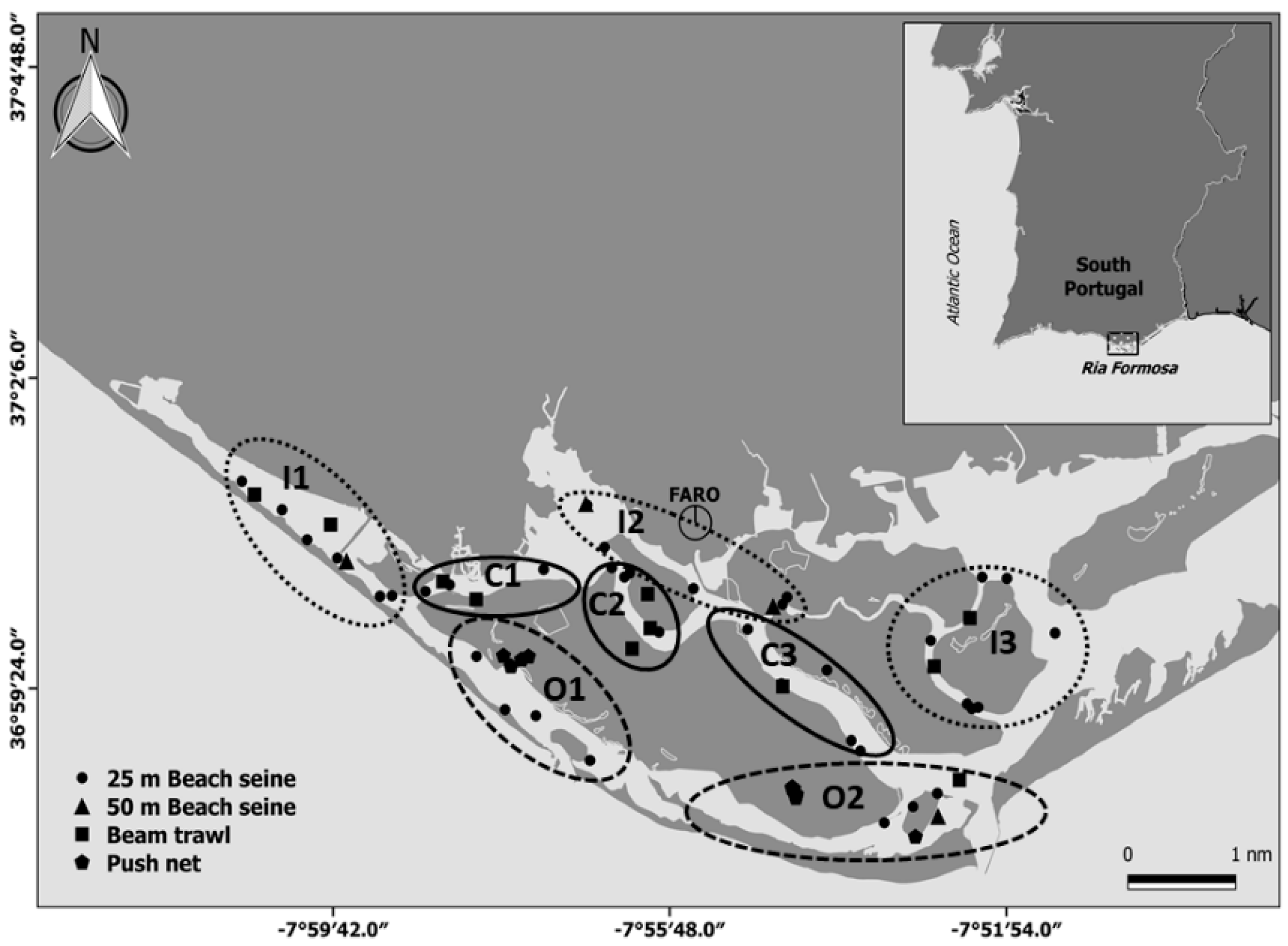
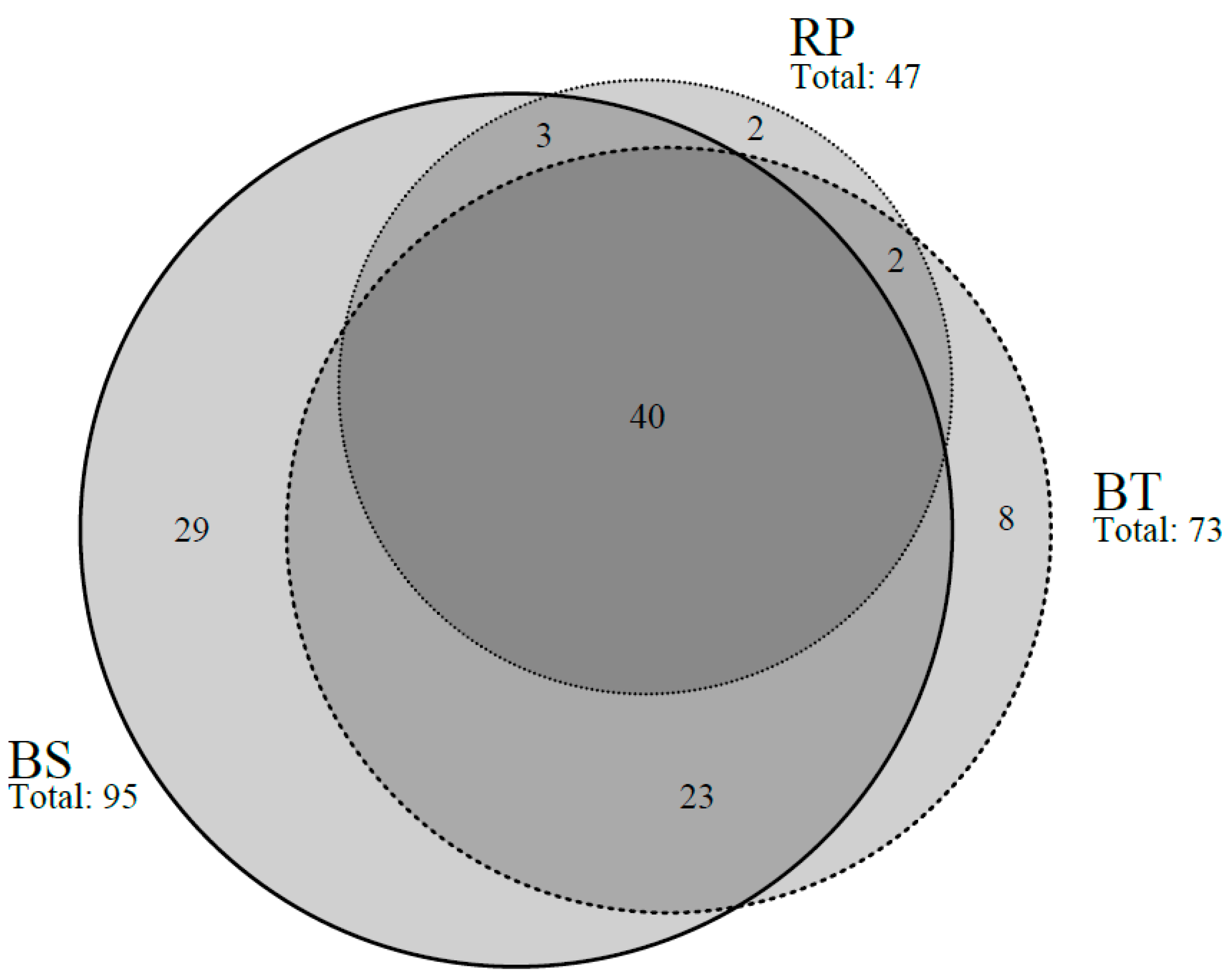
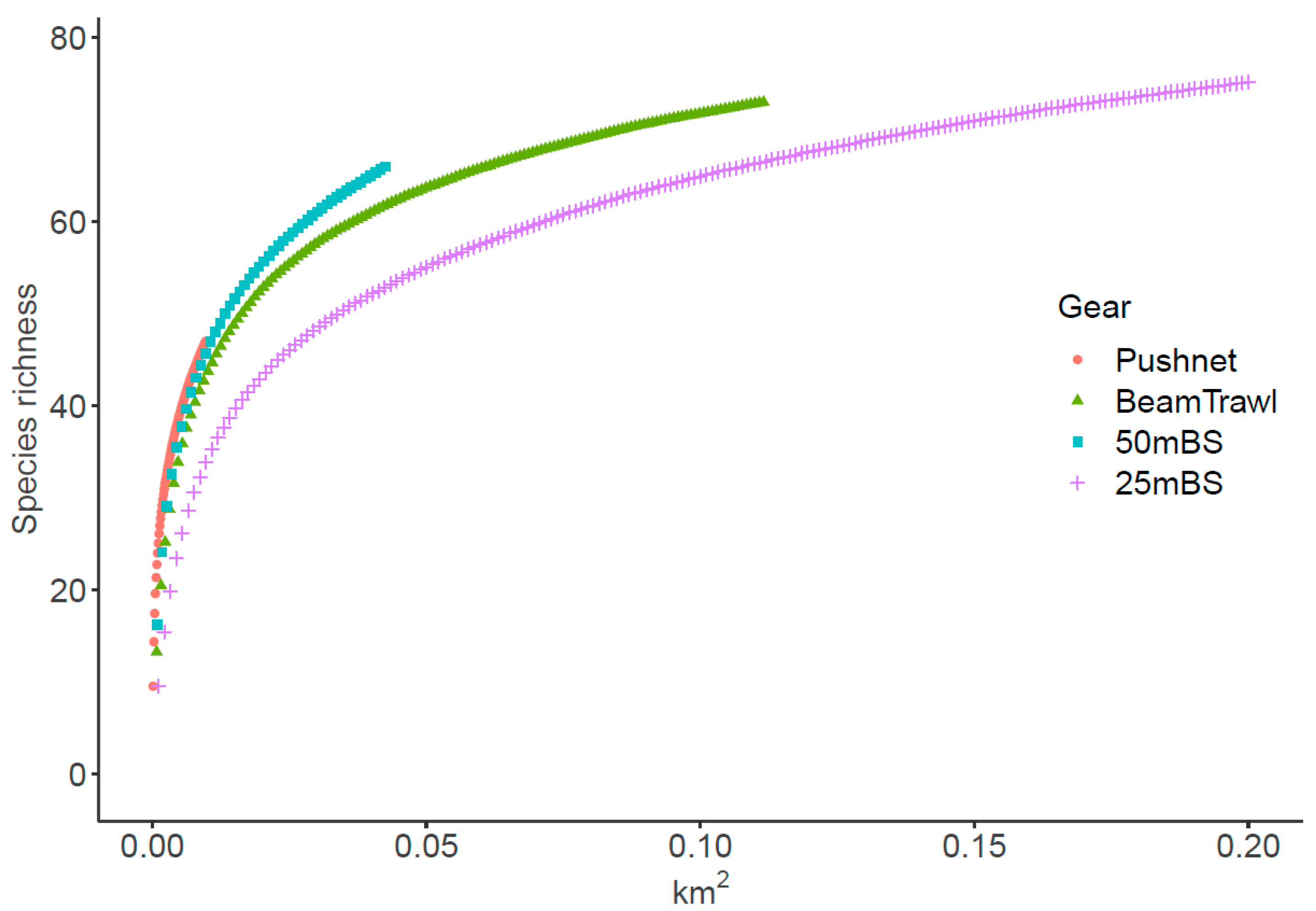

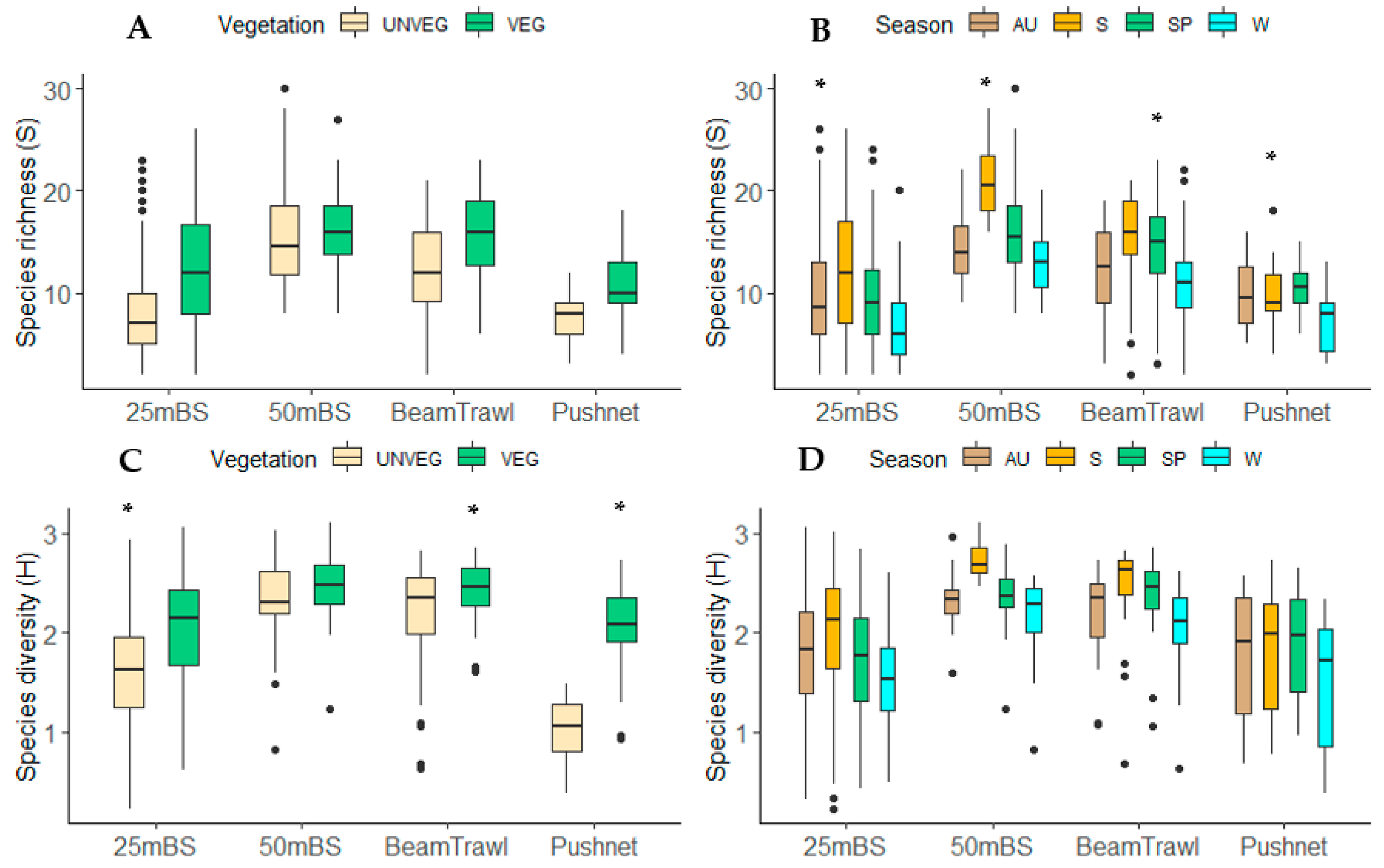
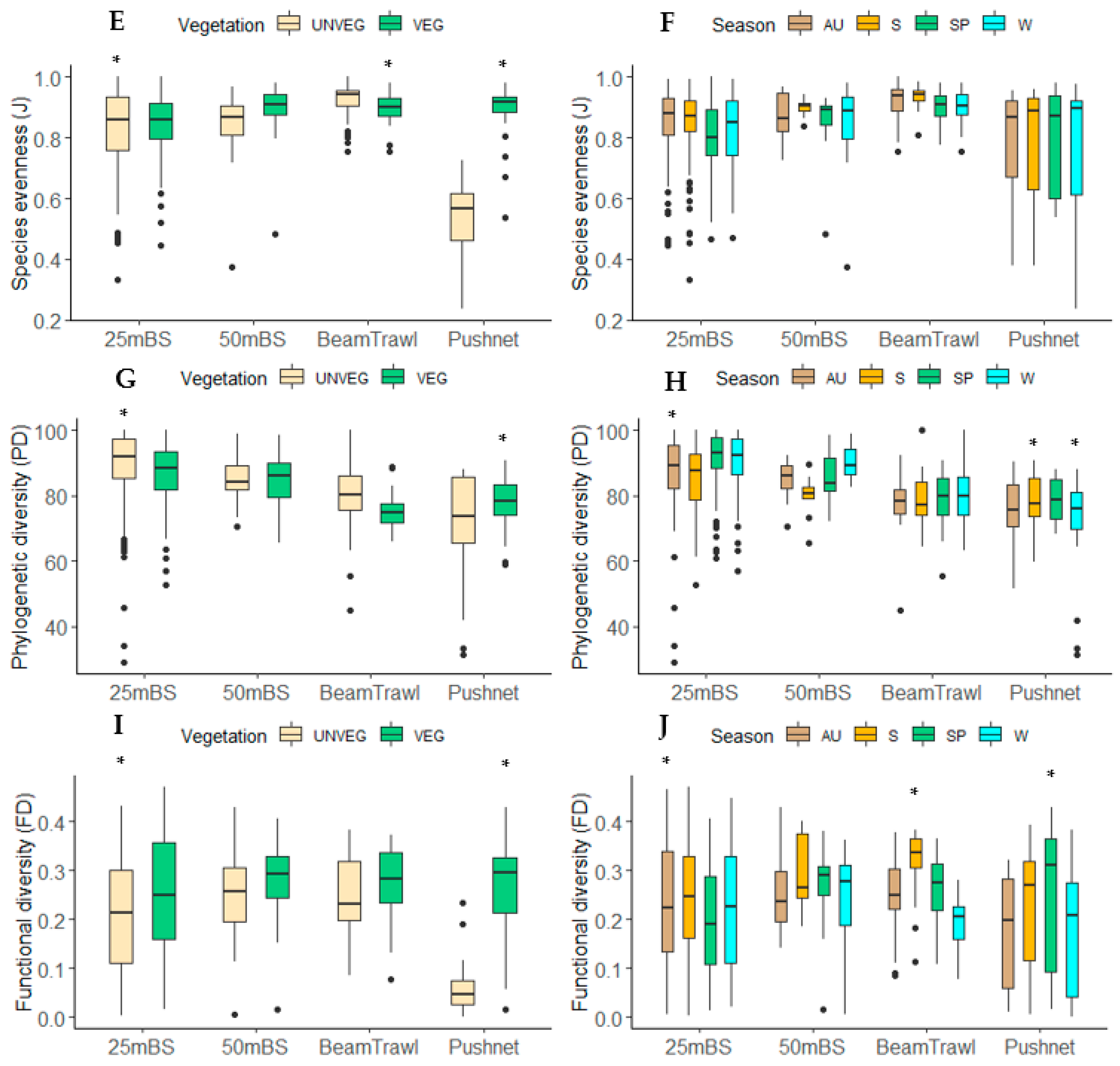
| Sampling Gear | Sampling Period | Sampling Locations | Total Samples | ||
|---|---|---|---|---|---|
| VEG | UNVEG | Total | |||
| 25-m beach seine | September 2000–December 2001 | 14 | 23 | 37 | 497 |
| 50-m beach seine | January 2001–January 2002 | 3 | 1 | 4 | 48 |
| Beam trawl | March 2001–March 2002 | 4 | 8 | 12 | 143 |
| Riley push net | April 2001–April 2002 | 3 | 3 | 6 | 72 |
| Functional Trait | Type | Units/Categories |
|---|---|---|
| Maximum body length | Continuous | Total length in cm |
| Trophic breadth | Continuous | Number of prey phyla consumed (from diet studies). Ranged from 1 to 9 (Plants/Algae, Mollusca, Arthropoda, Echinodermata, Chordata, Cnidaria, Nematoda, Porifera, Annelida) |
| Trophic level | Continuous | Index, range from 1 to 5. |
| Trophic group | Categorical | Planktivorous, Omnivorous, Herbivorous, Microinvertebrate feeders, Macroinvertebrate feeders and Piscivorous |
| Water column position | Categorical | Pelagic, Benthic and Benthopelagic |
| Preferred substrate | Categorical | Soft bottoms, Hard bottoms, Hard and Soft bottoms |
| Body shape | Categorical | Fusiform, Compressed, Depressed, Globiform, Elongated/Anguilliform |
Publisher’s Note: MDPI stays neutral with regard to jurisdictional claims in published maps and institutional affiliations. |
© 2022 by the authors. Licensee MDPI, Basel, Switzerland. This article is an open access article distributed under the terms and conditions of the Creative Commons Attribution (CC BY) license (https://creativecommons.org/licenses/by/4.0/).
Share and Cite
Adao, A.C.; Bosch, N.E.; Bentes, L.; Coelho, R.; Lino, P.G.; Monteiro, P.; Gonçalves, J.M.S.; Erzini, K. Complementary Sampling Methods to Improve the Monitoring of Coastal Lagoons. Diversity 2022, 14, 849. https://doi.org/10.3390/d14100849
Adao AC, Bosch NE, Bentes L, Coelho R, Lino PG, Monteiro P, Gonçalves JMS, Erzini K. Complementary Sampling Methods to Improve the Monitoring of Coastal Lagoons. Diversity. 2022; 14(10):849. https://doi.org/10.3390/d14100849
Chicago/Turabian StyleAdao, Ana C., Néstor E. Bosch, Luís Bentes, Rui Coelho, Pedro G. Lino, Pedro Monteiro, Jorge M. S. Gonçalves, and Karim Erzini. 2022. "Complementary Sampling Methods to Improve the Monitoring of Coastal Lagoons" Diversity 14, no. 10: 849. https://doi.org/10.3390/d14100849
APA StyleAdao, A. C., Bosch, N. E., Bentes, L., Coelho, R., Lino, P. G., Monteiro, P., Gonçalves, J. M. S., & Erzini, K. (2022). Complementary Sampling Methods to Improve the Monitoring of Coastal Lagoons. Diversity, 14(10), 849. https://doi.org/10.3390/d14100849










